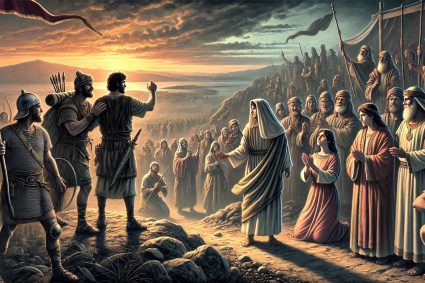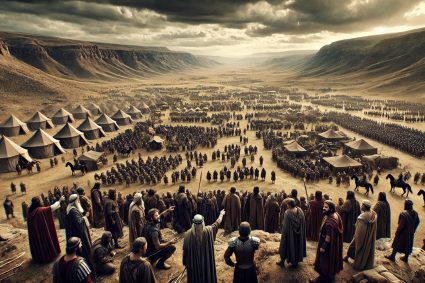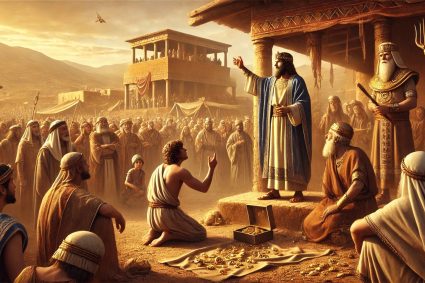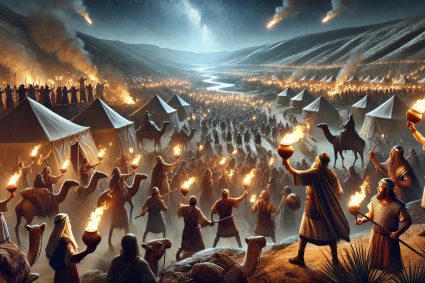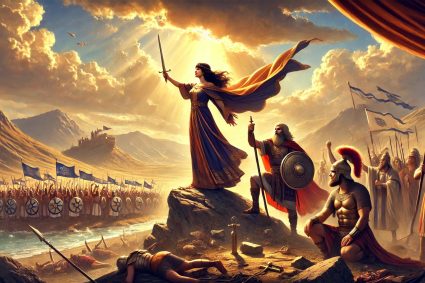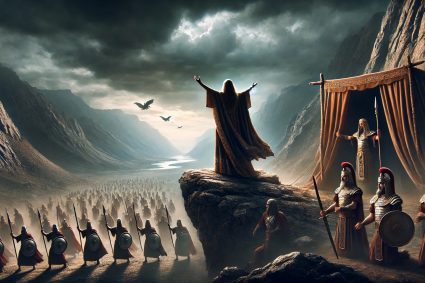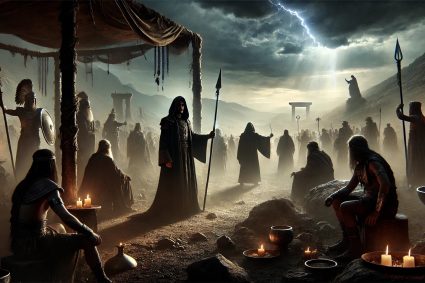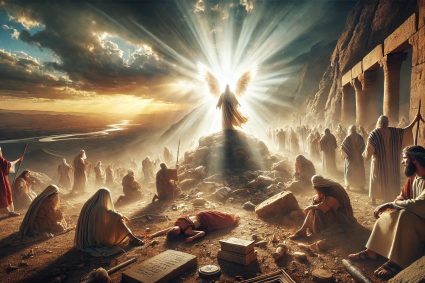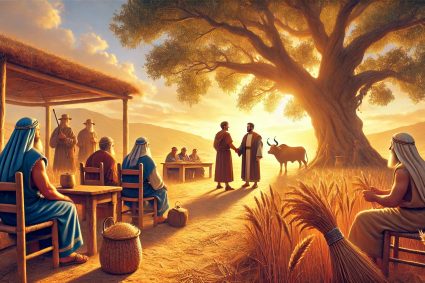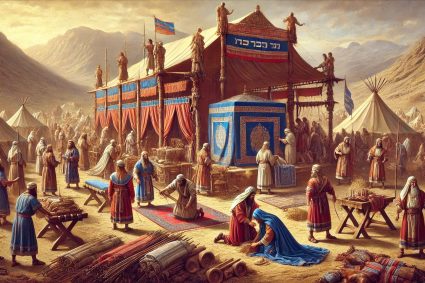
September 11, 2024
DAILY BIBLE READING – Mark Chapter 15
1 And straightway in the morning the chief priests held a consultation with the elders and scribes and the whole council, and bound Jesus, and carried him away, and delivered him to Pilate.
2 And Pilate asked him, Art thou the King of the Jews? And he answering said unto them, Thou sayest it.
3 And the chief priests accused him of many things: but he answered nothing.
4 And Pilate asked him again, saying, Answerest thou nothing? behold how many things they witness against thee.
5 But Jesus yet answered nothing; so that Pilate marvelled.
6 Now at that feast he released unto them one prisoner, whomsoever they desired.
7 And there was one named Barabbas, which lay bound with them that had made insurrection with him, who had committed murder in the insurrection.
8 And the multitude crying aloud began to desire him to do as he had ever done unto them.
9 But Pilate answered them, saying, Will ye that I release unto you the King of the Jews?
10 For he knew that the chief priests had delivered him for envy.
11 But the chief priests moved the people, that he should rather release Barabbas unto them.
12 And Pilate answered and said again unto them, What will ye then that I shall do unto him whom ye call the King of the Jews?
13 And they cried out again, Crucify him.
14 Then Pilate said unto them, Why, what evil hath he done? And they cried out the more exceedingly, Crucify him.
15 And so Pilate, willing to content the people, released Barabbas unto them, and delivered Jesus, when he had scourged him, to be crucified.
16 And the soldiers led him away into the hall, called Praetorium; and they call together the whole band.
17 And they clothed him with purple, and platted a crown of thorns, and put it about his head,
18 And began to salute him, Hail, King of the Jews!
19 And they smote him on the head with a reed, and did spit upon him, and bowing their knees worshipped him.
20 And when they had mocked him, they took off the purple from him, and put his own clothes on him, and led him out to crucify him.
21 And they compel one Simon a Cyrenian, who passed by, coming out of the country, the father of Alexander and Rufus, to bear his cross.
22 And they bring him unto the place Golgotha, which is, being interpreted, The place of a skull.
23 And they gave him to drink wine mingled with myrrh: but he received it not.
24 And when they had crucified him, they parted his garments, casting lots upon them, what every man should take.
25 And it was the third hour, and they crucified him.
26 And the superscription of his accusation was written over, The King Of The Jews.
27 And with him they crucify two thieves; the one on his right hand, and the other on his left.
28 And the scripture was fulfilled, which saith, And he was numbered with the transgressors.
29 And they that passed by railed on him, wagging their heads, and saying, Ah, thou that destroyest the temple, and buildest it in three days,
30 Save thyself, and come down from the cross.
31 Likewise also the chief priests mocking said among themselves with the scribes, He saved others; himself he cannot save.
32 Let Christ the King of Israel descend now from the cross, that we may see and believe. And they that were crucified with him reviled him.
33 And when the sixth hour was come, there was darkness over the whole land until the ninth hour.
34 And at the ninth hour Jesus cried with a loud voice, saying, Eloi, Eloi, lama sabachthani? which is, being interpreted, My God, my God, why hast thou forsaken me?
35 And some of them that stood by, when they heard it, said, Behold, he calleth Elias.
36 And one ran and filled a spunge full of vinegar, and put it on a reed, and gave him to drink, saying, Let alone; let us see whether Elias will come to take him down.
37 And Jesus cried with a loud voice, and gave up the ghost.
38 And the veil of the temple was rent in twain from the top to the bottom.
39 And when the centurion, which stood over against him, saw that he so cried out, and gave up the ghost, he said, Truly this man was the Son of God.
40 There were also women looking on afar off: among whom was Mary Magdalene, and Mary the mother of James the less and of Joses, and Salome;
41 (Who also, when he was in Galilee, followed him, and ministered unto him;) and many other women which came up with him unto Jerusalem.
42 And now when the even was come, because it was the preparation, that is, the day before the sabbath,
43 Joseph of Arimathaea, an honourable counsellor, which also waited for the kingdom of God, came, and went in boldly unto Pilate, and craved the body of Jesus.
44 And Pilate marvelled if he were already dead: and calling unto him the centurion, he asked him whether he had been any while dead.
45 And when he knew it of the centurion, he gave the body to Joseph.
46 And he bought fine linen, and took him down, and wrapped him in the linen, and laid him in a sepulchre which was hewn out of a rock, and rolled a stone unto the door of the sepulchre.
47 And Mary Magdalene and Mary the mother of Joses beheld where he was laid.
King James Version. Public Domain
Commentary
Introduction:
Mark 15 describes the final hours of Jesus before His crucifixion, His condemnation by Pilate, and His subsequent execution. The chapter highlights the political and religious tensions that led to Jesus’ death and illustrates both the injustice of the process and the profound symbolic significance of His suffering and dying. Particular emphasis is placed on the fulfillment of Old Testament prophecies and the reactions of those around Jesus, from the Roman centurion to the women who followed Him to the cross.
Commentary:
Mark 15 powerfully portrays the suffering and death of Jesus, making it clear that these events were motivated by both religious and political factors. Pilate, who recognizes the injustice done to Jesus, ultimately succumbs to the pressure of the crowd and condemns Him to be crucified. The depiction of Jesus as the suffering Messiah is central, as He consciously accepts the fate assigned to Him without defending Himself. His silence before Pilate demonstrates His determination to fulfill the divine plan. The mockery that Jesus endures contrasts with His true identity, which is only acknowledged by a Roman centurion after His death. Additionally, the darkness and the tearing of the temple curtain signify the profound meaning of Jesus’ death as a sacrifice that abolishes the separation between God and humanity.
Summary:
In the 15th chapter of the Gospel of Mark, Jesus is handed over to the Roman governor Pilate, who, despite being convinced of His innocence, condemns Him to death under pressure from the crowd and the chief priests. Barabbas, a rebel, is released, while Jesus is mocked, scourged, and ultimately crucified. On the way to His execution, Simon of Cyrene helps carry the cross. Jesus is crucified at Golgotha, is mocked, and dies with the words, “My God, my God, why have you forsaken me?” Upon His death, the temple curtain is torn, and the Roman centurion acknowledges that Jesus was the Son of God. Joseph of Arimathea ensures His burial.
![]()

WEEKLY SPIRIT OF PROPHECY READING – Ellen White | The Desire of Ages
Chapter 61—Zacchaeus
This chapter is based on Luke 19:1-10.
Read online here
Commentary
Introduction:
The story of Zacchaeus in Luke 19:1-10 is a powerful narrative of conversion, repentance, and forgiveness. It takes place in Jericho, a wealthy city known for its lush vegetation and economic prosperity. At the center of the story is Zacchaeus, a tax collector who is despised by society for his profession and wealth. However, his encounter with Jesus becomes a turning point in his life, as he experiences a radical transformation through the grace of Jesus.
Commentary:
Zacchaeus, the chief tax collector, was a man who possessed wealth and power but was inwardly dissatisfied and guilty. His profession, often associated with injustice and extortion, had alienated him from his people. Yet, Zacchaeus was open to change. When he heard about Jesus, the teacher who welcomed even the outcasts, a hope for a better life was kindled within him. This shows that in every person, even the most despised, there is a desire for renewal.
The circumstances under which Zacchaeus encounters Jesus are symbolic of his inner state: he is small in stature and cannot see over the crowd. This reflects his social standing, but he overcomes this obstacle by climbing a tree—a sign of his intense desire to see Jesus. This gesture is rewarded when Jesus speaks to him directly and announces that he will stay at his house.
The reaction of the crowd, criticizing Jesus for staying with a “sinner,” is typical of the religious elites of that time who excluded people like Zacchaeus. But Jesus makes it clear that his mission is to save those who are lost, not just the righteous. Zacchaeus’ repentance is deep and sincere; he offers to give half of his wealth to the poor and repay those he has wronged four times over.
This encounter reveals the transformative power of forgiveness and grace. Zacchaeus’ conversion is an example of true repentance, which manifests in concrete actions. It is not enough to confess mistakes; they must also be corrected, just as Zacchaeus does. His decision to support the poor and make restitution shows that he has internalized Jesus’ teachings.
Summary:
The story of Zacchaeus is a narrative about conversion, grace, and the power of forgiveness. Although he was a wealthy and despised tax collector, his encounter with Jesus shows that no one is beyond the reach of God’s mercy. Zacchaeus’ repentance is radical and sincere, as he is willing to correct his wrongs and help those in need. This story teaches us that true conversion is not only visible in words but also in concrete actions, and that Jesus comes to those who seek a new beginning. It reminds us that God’s grace can transform even the hardest hearts.

WEEKLY SPIRIT OF PROPHECY READING – Ellen White | The Desire of Ages
Chapter 62—The Feast at Simon’s House
This chapter is based on Matthew 26:6-13; Mark 14:3-11; Luke 7:36-50; John 11:55-57; John 12:1-11.
Read online here
Commentary
Introduction:
The feast at Simon’s house in Bethany, based on the Gospel accounts (Matthew 26:6-13; Mark 14:3-11; Luke 7:36-50; John 11:55-57; John 12:1-11), is a profound episode in the life of Jesus. This feast, hosted by Simon, a healed Pharisee, shows us the connection between gratitude, repentance, and divine forgiveness. The accounts highlight the tensions between genuine expressions of love and the selfishness present in the hearts of the disciples and other attendees.
Commentary:
The feast at Simon’s house is particularly marked by Mary’s action of anointing Jesus with expensive nard oil. This gesture represents deep love and devotion to Christ, as Mary wanted to thank him for the forgiveness of her sins and the raising of her brother Lazarus. Her act demonstrates how true gratitude is expressed through concrete, selfless actions, regardless of external criticism. However, Judas, who considered the anointing a waste, revealed his selfish nature, which ultimately led him to betray Jesus.
It is interesting to see how Jesus gently corrects Simon’s self-righteous thoughts. While Simon had been healed by Jesus, he had not yet fully understood the depth of forgiveness. Through the parable of the two debtors, Jesus illustrates that forgiveness and love are interconnected. Those who receive great forgiveness also show greater love. Simon’s pride and judgment were exposed, and through Jesus’ gentle rebuke, he recognized his own guilt.
The reaction of the disciples, who initially criticized Mary’s action, reveals their immaturity in understanding devotion. Jesus’ acknowledgment of Mary’s deed teaches us that true devotion and love are never wasted. Jesus recognized the anointing as a symbolic act pointing to his impending death, and he blessed Mary for her prophetic insight.
Summary:
The feast at Simon’s house is a moving example of the contrast between genuine devotion and selfishness. While Mary anointed Jesus out of deep gratitude and love, Judas was driven by greed and self-interest. Through his parable and reaction to Mary’s action, Jesus shows that love and forgiveness are central to faith. Simon’s pride and Judas’ betrayal stand in stark contrast to Mary’s selfless love, which serves as a model for future generations. This episode teaches us the importance of expressing our faith through acts of love and devotion.
(Visited 16 times, 1 visits today)



